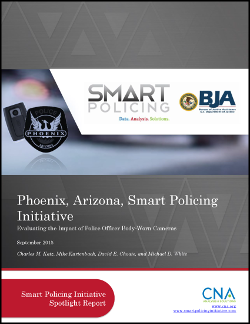
A number of highly publicized deaths of citizens at the hands of the police have sparked a national debate over police accountability—with body-worn cameras (BWCs) at the center of the debate. BWCs enjoy support from many law enforcement agencies, citizen advocacy groups, civil rights organizations, politicians, and the federal government. Though there has been wide-ranging speculation over the potential impact and consequences of BWCs, few rigorous examinations of the technology have been conducted, and many questions remain unanswered.
The Bureau of Justice Assistance (BJA), through the Smart Policing Initiative (SPI), funded the Phoenix Police Department to purchase, deploy, and evaluate police body-worn cameras. In the study, the Phoenix SPI team deployed 56 BWCs to officers in one of the two Maryvale Precinct squad areas. All officers assigned to the target area were issued BWCs, and officers in the adjacent squad area served as a comparison group. Cameras were deployed in the field in April 2013, and the study period covered approximately 30 months (15 months pre-deployment; 15 months post-deployment).
The evaluation of BWCs, led by the research partners at Arizona State University, focused on six critical areas: (1) officer camera activation compliance, (2) officer perceptions of the wearability and utility of body-worn cameras, (3) impact on officers’ job performance, (4) impact on public compliance and cooperation, (5) impact on officer accountability, and (6) impact on domestic violence case processing and outcomes.
The study found the following: (1) Officer compliance with the activation of BWCs was generally low (under 30 percent), varying by call type (between 6 percent and 48 percent). (2) Police perceptions of BWCs changed notably over time, as officers reported increased comfort and ease as well as greater recognition of the benefits of the technology. (3) BWCs appeared to increase arrest activity. (4) BWCs did not seem to change citizen behavior, based on resisting-arrest charges. (5) BWCs appeared to significantly reduce complaints against officers (23 percent drop) when compared with officers in the other squad area (10 percent increase). (6) Finally, BWCs improved the processing of domestic violence incidents, as cases with video were more likely to be charged and successfully prosecuted, although BWCs did result in longer case processing times.
The Phoenix SPI study produced a number of important lessons learned. The decision to deploy BWCs represents an enormous investment in resources and manpower. It is important for police managers to be strategic, deliberate, and collaborative in planning their BWC program. Coordination with the Prosecutor’s Office is absolutely critical. Training, policy development, and transparency with line officers also are essential for a successful BWC program. The perceived benefits of BWCs hinge on their use and proper operation in accordance with departmental policy. That is, the benefits of BWCs can be realized only if officers appropriately activate the cameras during police-citizen encounters.
Line officers should become educated consumers regarding BWCs, and both line officers and police managers should be realistic about the potential impact of the technology on police operations, encounters with citizens, and community perceptions of police legitimacy.
